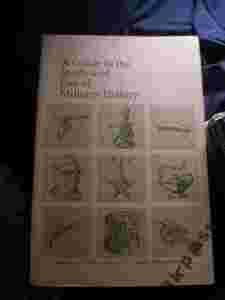
Numer Bibliospisu - L5
the guide to the study and use military history
Center of Military History Uniteg States Army
On 6 June 1944, as the allied forces began the invasion of Normandy, General George S. Patton, Jr., wrote to his son, then a cadet at the United States Military Academy, that "to be a successful soldier, you must know history." The number of similar pronouncements from noted military figures, including Napoleon, is almost endless and the basic refrain is the same -- to understand the present and to prepare for the future -- the study of history is vital. This applies most particularly to those who lead men in battle. As Marshall Foch wrote, "no study is possible on the battlefield, one does simply what one can in order to apply what one knows." Despite vast changes in technology since World War II, the combat leader may still learn much from the study of past battles and campaigns. Weather, terrain, and intelligence of friendly and enemy dispositions, for instance, are as important today as in the days of Alexander, Frederick the Great, and Napoleon; human reactions in combat remain relatively constant.
Quite beyond vicarious experience of the battlefield, the study of military history affords and understanding of the interplay of forces that have shaped the present and provides the means of viewing current problems against the long perspective of how men have handled similar problems in the past. The immediate utility of knowledge of history is likely to vary with the situation in which the individual soldier finds himself. Certainly force planners could profit from a study of the varying approaches of General Pershing and General Marshall in the two world wars toward the size and composition of the Army, officers in charge of training from a reminder that the American soldier's traditional outlook was not conducive to fighting a counterinsurgency war in Vietnam, and military leaders and policy makers alike from an appreciation of the long American tradition against drafting men for combat service in anything short of an all-out national war effort. Knowledge of military history cannot produce solutions to all problems, nor can it guarantee success in a military career. But it can provide a foundation for both problem solving and career achievement.
This Guide to the Study and Use of Military History is designed to foster an appreciation of the value of military history and explain its uses and the resources available for its study. It is not a work to be read lightly tossed aside, but one the career soldier should read again or use as a reference at those times during his career when necessity or leisure turns him to the contemplation of the military past.
The Guild consists of four parts. Part One is general in nature and deals with the nature of history s a discipline, military history as a branch of that discipline, the uses of military history, and suggested methods of reading and study.
Part Two is a guide to the areas of study and the materials available for study in each. It consists of seven bibliographical essays - one on the great military historians and philosophers with whom all students of military history should have some acquaintance, two on world military history, three specifically on American military history, and a final essay on the merging of American and world military history since the end of World War II. Each of the period essays weaves its bibliographical information into the framework of a discussion of the main military developments of the era covered, introducing, where pertinent, varying historical interpretations of events and issues. Each contains at the end an alphabetical listing of all works mentioned.
Part Three deals with U.S. Army historical programs and activities and how the Army uses or has used military history. This part informs the reader of the resources available within the Army for study and research in military history and some of the practical uses of history in staff work.
Part Four similarly deals, albeit more briefly, with military history outside the Army - in other elements of the Department of Defense, in foreign military establishments, and in the academic world.
Finally two appendices provide annotated listings of reference works and historical periodicals of greatest interest and utility to the student of military history.
The longest part of the Guide, Part Two, contains the bibliographical essays, generally modeled on the bibliographical pamphlets published by the American Historical Association Center for Teachers. Like them, each individual essay, written by a specialist in the field, adopts a somewhat different approach. All of them, however, must list many works within a relatively short space to give the reader some understanding of the vast variety of historical literature available. Bibliographic essays seldom make light bedtime reading, and those in the Guide are no exception. But the editors do believe these essays can be read initially with interest and profit for a general appreciation of the whole field of military history, and then used later as a more detailed reference when the student develops an interest in a particular period or subject. Except in the essay on the great military historians, and philosophers, only works written in English or translated into English have been included. And there is relatively heavy emphasis on American military history as opposed to the broader field of world military history. The reason is simply the belief that books in the national language and on the national experience will be of greatest interest and utility to the American officer.

